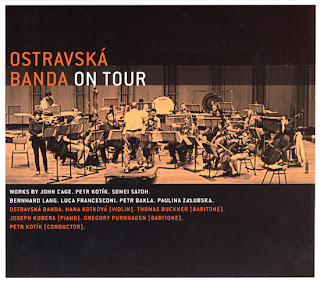Monday, July 4, 2011
Ostravská Banda: On Tour
Ostravská Banda
On Tour
(Mutable)
by Kurt Gottschalk
The versatile 20-piece Ostravská Banda might be seen as a cultural-ambassador assembly for the biennial Ostravská Days festival, a growing part of the Czech Republic's new music landscape. Initiated in 2001, the festival is dedicated to contemporary orchestral works. In 2005, the Banda was founded by SEM Ensemble conductor Peter Kotik to give the festival its own standing orchestra and to create a touring body to represent the work.
The seven compositions presented over the two hours of the double CD On Tour were recorded in 2010 at appearances in Poland, Austria, the Netherlands and the Czech Republic. The program represents some pillars of 20th Century composition as well as – can we call it post-20th Century music, the patron saint being, unsurprisingly, John Cage, and the ensemble presents a challenging reading of his Concert for Piano and Orchestra. The piece comes with a Czech footnote: While it allows for variable instrumentation, it was only in Prague in 1964 that he was able to give the first full presentation of the piece following its 1958 New York premiere. The piece is constructed (as is true with so many of Cage's works) in time intervals, with allowable events for individual instruments – scored or suggested sounds – happening within the time brackets. The featured pianist is given the most complex part, with a book of 64 one-page scores from which to choose.
With the talented American pianist Jospeph Kubera at the fore, the piece is given a dramatically disparate performance – appropriate for the work, even if it is surprising give the fullness of the rest of the tracks. Musical gestures don't fall together, they just occur, as famously is the composers intention. The orchestra recedes to the background as the piano – bright and abrupt – dominates the soundspace. The noncohesivesness becomes a richness in field over its 23 minutes, something the composer no doubt would have appreciated.
That piece starts off the second disc of the set, and is followed by Kotik's 2009 composition In Four Parts [3, 6 & 11] for John Cage. It's a tightly constructed homage to the earlier composer's first love, percussion music, and is a taut and dynamic 24 minutes – so much so that it leaves Bernhard Lang's 2008 percussion piece Monadologie IV in its shadow. As opposed to the rigors of Kotik's piece, the Monadologie comes off as a sort of exploded drum solo, that is, more showy than satisfying. Thirty-six minutes of percussion music might be a bit much for some listeners, and it does make for a diminished finale.
The first half of the set opens with a wonderfully romantic flourish. Luca Francesconi's 1991 Riti Neurali follows (as the liner notes point out) the instrumentation of Schubert's Octet in F Major, although it speaks in the dramaturgy of Schoenberg; The violin-dominated flurry is exhilarating. While Francesconi studied under both Berio and Stockhausen, here he speaks in a language of measured atonality and straightforward passion.
That piece is followed by two works by young composers, both vivid and exciting, and quite different from one another. The 31-year-old Petr Balka's Serenade is a wonderful construction of differing tonal qualities. Bold outbursts are laid over quieter and sometimes fairly simplistic phrases in unexpected ways, creating a tableau of phrases with the energy of potentiality, of what the composer calls “not-quite-yet-music.” The 27-year-old Polish composer Paulina Zalubzka works with varieties of lyricism reminiscent in ways of both the Francesconi and Bakla pieces in her Dispersion, its persistent rhythm moving in and out over unabashedly beautiful passages.
The only non-Western composer present here is the Japanese Somei Satoh, represented by a half-hour “reduced setting” of his The Passion. With inventive use of a male choir and strong performances from baritones Thomas Buckner and Gregory Purnhagen. The piece is just beautiful, an unusual juxtaposition of minimalist gesture and rich harmony.
The impetus behind producing such a strong and varied package as On Tour may or may not have been to serve as a calling card for the ensemble and, by extension, the festival. But either way, the point is well made.
Labels:
CZ,
John Cage,
Kurt Gottschalk
Subscribe to:
Post Comments (Atom)

Remember that a wooden bird cage is fragile and could be damaged if cleaned. Perhaps those cages would be better of for use as an accessory or a table centerpiece.Finding a used bird cage may take you some time, but you can find some great buys for your feathered friend.
ReplyDelete